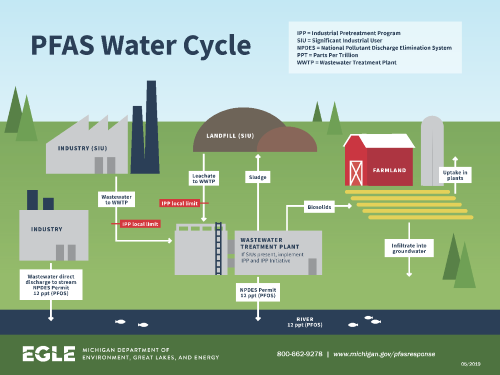While many states are looking at ways to manage PFAS while awaiting a risk assessment from the U.S. Environmental Protection Agency, the State of Michigan has taken an approach that shouldn’t be overlooked.
In response to the ongoing concerns around PFAS, Michigan’s Environment, Great Lakes, and Energy (EGLE) has taken steps to address these concerns in biosolids but with a different approach that looks upstream from wastewater recovery facilities (WRRF). Michigan began implementing an Industrial Pretreatment Program (IPP) PFAS initiative in February 2018.
The IPP program directs WRRFs to sample their effluent and identify industrial users. If effluent samples detect PFOS at 12ppt or higher, then the WRRF implements source reduction at identified industrial users.
Michigan completed a study to review WRRF influent, effluent, and biosolids at 42 facilities, along with 29 biosolids land application sites in 2020. All of the facilities had effluent concentrations below state drinking water standards (420 ng/L) for PFOA.
PFOS effluent was higher than drinking water standards (11 ng/L) at 7 of the 42 sites that had also received high concentrations of PFOS in their influent. Land application sites generally had higher PFOS concentrations in soils, surface water, and shallow groundwater where biosolids with higher concentrations of PFOS were applied. This led EGLE to set PFOS as the driver for regulatory compliance.
In 2021 EGLE released their land application Interim Strategy (updated in April 2022) to address PFOS in biosolids. An annual requirement for testing prior to land application must meet specific PFOS tier requirements:
PFOS at or above 125 μg/kg
- Biosolids exceeding 125 μg/kg PFOS are deemed to be industrially impacted and cannot be land applied.
- Immediately notify EGLE, WRD staff.
- Sample effluent and investigate potential sources to develop a source reduction program, if they have not already done so under the IPP PFAS Initiative.
- Arrange alternative treatment or disposal of solids.
PFOS at or above 50 μg/kg but below 125 μg/kg
- Immediately notify EGLE, WRD staff.
- Sample effluent and investigate potential sources to develop a source reduction program, if they have not already done so under the IPP PFAS Initiative.
- To reduce overall loading to the site, reduce land application rates to no more than 1.5 dry tons per acre (or submit an Alternative Risk Mitigation Strategy).
PFOS above 20 μg/kg, but below 50 μg/kg.
- EGLE recommends investigating sources and sampling the WWTP effluent for PFAS. Guidance can be obtained from the WRD IPP PFAS staff.
- If a WWTP on the Permit Cycle (five year) sampling frequency has a PFOS result above 20 μg/kg, the WWTP will be required to sample each year the WWTP intends to land apply, prior to land application.
PFOS at or below 20 μg/kg
- This number is based on the averages derived from the Summary Report: Statewide Biosolids and WWTP Study and other available data. No additional requirements to comply with the Interim Strategy.
While Michigan is awaiting scientific risk assessments to be completed by the EPA, they are working with WRRFs toward reducing PFOS levels from industrial users and setting limits for biosolids application to protect both farmers receiving Biosolids and public health.


